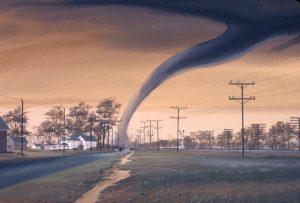
Natural disasters occurred in every state over the course of 2020 in the tunes of thousands of these events sprinkled across the states. While one would expect California or Florida to lead in the amount of natural disasters that occur every year, though in reality the states with the highest counts were South Dakota, Virginia, and Texas.
Winter storms in Texas, for example, accounted for 40% of the total losses in the U.S. property insurance market during the first half of 2021.
Homeowners should not be shocked to find that their property insurance rates are going up this year—one way or another insurers need to be able to cover their risk amid rising numbers (and severity) of natural disasters that are now occurring across the country on a near-daily level.
A new paper from SitusAMC [1] describes how climate change starts with a warming ocean which in turn creates stronger, more frequent hurricanes, and create drought patterns turning the western portion of the continent into a “tinderbox” ripe for wildfires.

"The growing number of climate events has left the insurance industry reeling," said Jennifer Rasmussen [2], PhD, Vice President and Head of Thought Leadership and Publications for SitusAMC Insights, a division of SitusAMC, and co-author of the white paper. "Many insurers and reinsurers have already seen their 2020 financials severely downgraded. As the intensity and scope of future catastrophes grow, insurance rates for property owners will likely rise significantly in the near future."
“As these events become more intense, and spread to other regions, the property market will face serious cost burdens from the destruction from these storms,” the report said. “In 2020, the states with the most property damage resulting from major storms collectively lost $23 billion in property damage, according to Moody’s Analytics. And neither Florida nor California, nor Iowa—which lost an estimated $7.5 billion from a derecho—were included in that ranking. Louisiana, which bore the brunt of Hurricanes Laura and Delta, took the most property damage, followed by Oregon, Texas, Tennessee and Washington.”
The migration habits of people are not helping either. Based on current data “more people are moving to fire-prone and flood-prone areas in the West and Southeast. Current migration trends will place an additional 1.2 million homes at risk for flooding over the next 30 years, an increase of 10% from today, according to data from First Street Foundation.”
Rates in some places may rise faster than homeowners can afford, leading them to obtain a policy from an “insurer of last resort” which may be available to them, but at a cost of greatly-reduced coverage.
Many insurance companies draw from reinsurance policies to protect themselves from natural catastrophes. However, the reinsurance industry has been experiencing losses for years, and is currently passing along cost increases to insurers, which will ultimately impact property owners, the white paper stated.
"Most people may not be surprised to hear insurance rates are going up, but few understand how precarious the situation is for the insurance industry," said Rasmussen. "As the number of climate-related disasters increase, many homeowners and residential real estate investors could be in for a rude awakening in the years ahead."